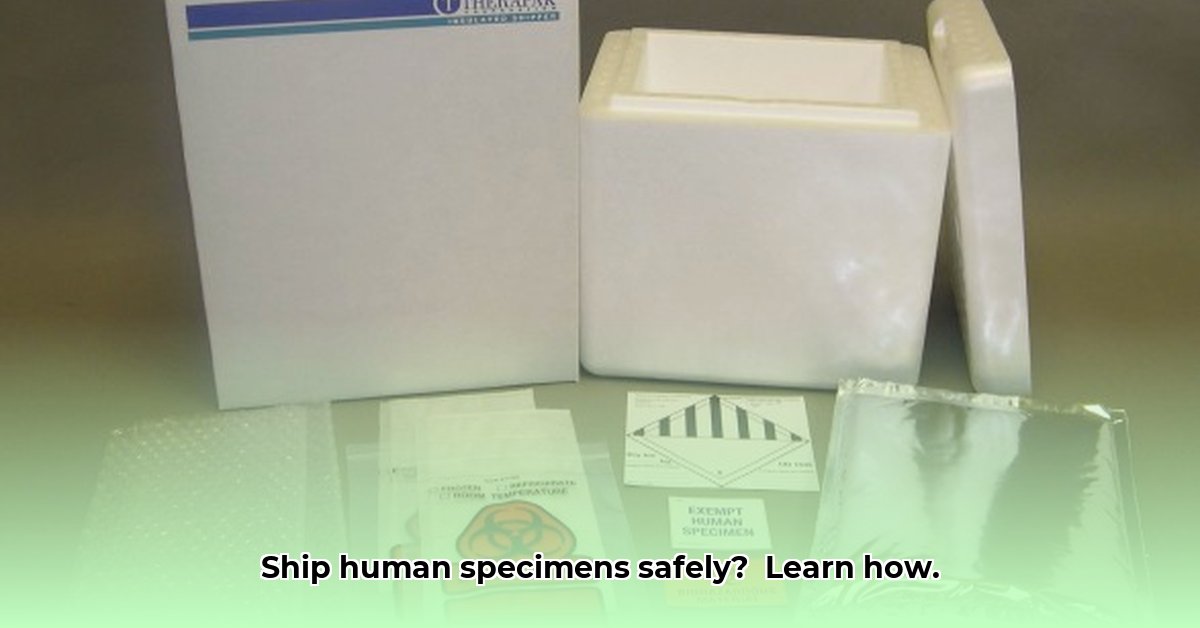Shipping human samples requires careful attention to regulations and carrier-specific guidelines. This comprehensive guide provides clear, actionable instructions for the safe and compliant shipping of exempt human specimens, ensuring your samples arrive securely and mitigating potential risks throughout the process.
Understanding Exempt Human Specimen Shipping: A Step-by-Step Guide
Shipping exempt human specimens involves several critical steps. This guide will break down the process, from properly defining “exempt” to understanding carrier-specific regulations, ensuring your shipments meet all requirements. A strong grasp of human specimen transportation nuances and the critical role of triple packaging is vital for maintaining full compliance.
Defining “Exempt” Human Specimens: Identifying Low-Risk Samples for Shipment
What constitutes an “exempt” human specimen? These are specimens considered to have a low probability of containing infectious diseases. Examples include routine blood tests for non-infectious conditions, anonymized research samples, or discarded tissue samples intended for quality control or training purposes. Accurate classification is essential; misclassifying a specimen can lead to significant regulatory violations and safety risks. Consult current regulations from IATA/ICAO and specific carrier guidelines, as definitions and requirements may change.
Mastering Triple Packaging: Ensuring Specimen Protection and Integrity
Triple packaging is a crucial safety measure, creating a multi-layered barrier that protects your samples and anyone handling them during transit. This packaging method minimizes the risk of leaks, damage, and exposure.
Step 1: Primary Container – The First Line of Defense: This receptacle holds the specimen directly. Use a leak-proof, watertight container with a positive closure (screw-on, snap-on, or push-on lid taped for an additional seal) for liquid samples. For solid specimens, use a rigid, puncture-resistant container. When using multiple fragile primary receptacles in a single secondary receptacle, individually wrap or separate them to prevent contact.
Step 2: Secondary Container – Added Protection and Absorbency: This container surrounds the primary container, providing cushioning and absorbing any leaks or spills. Place sufficient absorbent material (cellulose wadding, cotton balls, super-absorbent packets, or paper towels) between the primary and secondary receptacles. The amount of absorbent material must be sufficient to absorb the entire contents of all primary receptacles. The secondary container itself should also be watertight and sealed (e.g., a sealed plastic bag, plastic canister, or screw-cap can).
Step 3: Outer Packaging – The Final Shield: This is a sturdy, rigid outer packaging constructed of corrugated fiberboard, wood, metal, plastic, or another equally strong material. Ensure the outer packaging is of adequate strength for its capacity, mass, and intended use. Chipboard, paperboard boxes, and paper envelopes are unacceptable as outer packaging. The outer packaging should be appropriately sized for the contents and must meet minimum size requirements (at least one surface with a minimum dimension of 3.9 inches by 3.9 inches or 100 mm by 100 mm). For added protection, consider placing the outer packaging in an overwrap/overpack.
Note: Packaging guidelines may vary by carrier. Always consult the specific carrier’s website (FedEx, UPS, USPS) for their most up-to-date requirements.
Labeling for Compliance: Essential Information and Markings
Clear and accurate labeling is vital for smooth delivery and regulatory compliance. Your label should prominently display:
- “Exempt Human Specimen” or “Exempt Animal Specimen” – Crucial for proper identification and handling.
- Your Complete Return Address – Including name, street address, city, state, and zip code for prompt return if issues arise.
- Recipient’s Full Address – Accurate and complete delivery address, including name, street address, city, state, zip code, and contact phone number.
- Special Handling Instructions – Include any specific instructions, such as temperature requirements (e.g., “Maintain 2-8°C”), or “Do Not Freeze”.
Consider adding a biohazard symbol, especially for blood-containing specimens, to provide a visual indication of the contents and the need for careful handling. However, note that the biohazard symbol alone is not sufficient and must be accompanied by the “Exempt Human Specimen” marking.
Carrier-Specific Guidelines: FedEx, UPS, and USPS
Each carrier—FedEx, UPS, and USPS—has specific rules and regulations for shipping exempt human specimens. Always consult their websites or contact their hazardous materials departments for the most current requirements before shipping. International shipments, often governed by IATA/ICAO regulations, require even more precision and documentation. Never assume familiarity; double-check every detail with the carrier. Ignoring these specific guidelines can lead to delays, fines, or even legal repercussions. Consult official carrier websites for the most up-to-date information.
Special Considerations: Temperature and Unique Specimens
Temperature-sensitive specimens require insulated packaging and appropriate coolants (ice packs, dry ice) or heating elements to maintain integrity. Use validated temperature-monitoring devices to document conditions during transit. Larger or unusually shaped specimens may require pre-shipment consultation with the carrier to ensure proper handling and packaging. For refrigerated or frozen specimens shipped with ice, ensure the ice or ice packs are placed between the secondary packaging and the outer packaging. If using ice, the outer packaging must be leak-proof. If using dry ice, the outer package must permit the release of gas.
Risk Mitigation: Proactive Strategies
Address potential risks with proactive strategies to minimize the likelihood of incidents.
| Risk Factor | Mitigation Strategy |
|---|---|
| Packaging Failure | Use high-quality, UN-certified packaging materials; perform thorough quality checks before sealing and shipping; ensure proper closure and sealing of all containers. |
| Mishandling in Transit | Select reliable carriers with experience in handling biological specimens; label packages clearly and conspicuously; use tracking services. |
| Regulatory Non-Compliance | Thoroughly understand and adhere to all applicable regulations (IATA, ICAO, DOT, carrier-specific); maintain detailed records of training and compliance procedures; seek expert advice when needed. |
| Temperature Excursion | Use temperature-controlled packaging (insulated shippers, phase change materials); use validated temperature monitoring devices to track temperature throughout the shipping process; pre-qualify shipping lanes to understand temperature profiles. |
| Loss/Theft | Utilize tracking services; consider purchasing insurance to cover potential losses; implement chain-of-custody procedures to track the specimen from origin to destination. |
| Delays | Plan shipments carefully, considering potential delays due to weather, holidays, or customs inspections; use expedited shipping services when necessary; communicate proactively with the recipient to coordinate delivery. |
Frequently Asked Questions (FAQs)
-
Q: Can I use plastic bags for the secondary container? A: While a plastic bag can be used as part of the secondary containment, it must be a watertight sealed plastic bag. The secondary container must also incorporate sufficient absorbent material to absorb the entire contents of the primary container(s).
-
Q: What size box is recommended for the outer packaging? A: The outer packaging must be large enough to accommodate the secondary package with sufficient cushioning material to protect the contents during transit. The smallest external dimension must be at least 100mm x 100mm (approximately 4 inches x 4 inches). Refer to the respective carrier’s website for more specific details and dimensional weight restrictions.
-
Q: What are the consequences of non-compliance? A: Penalties for non-compliance can range from hefty fines and shipment delays to legal repercussions, including civil and criminal charges. Non-compliance can also jeopardize the integrity of the specimens and potentially endanger public health.
Shipping exempt human specimens requires meticulous planning and unwavering attention to detail. By following these steps, staying informed about current regulations, and adhering to best practices, you can ensure the safe, compliant, and secure transport of your valuable samples.
How to Comply with FedEx, UPS, and USPS Regulations for Shipping Exempt Human Specimens
Understanding “Exempt” Specimens: Confirming Accurate Classification
Clarify exactly what constitutes an “exempt” human specimen according to the specific regulations governing your shipment. Regulations vary based on specimen type, origin, destination, and the governing body (e.g., IATA, DOT, USPS). Always verify with the relevant guidelines and consult with the carrier to avoid costly mistakes and potential delays. Understanding specific specimen requirements before you begin the shipping process can prevent delays, fines, and other complications.
Triple Packaging: The Ultimate Fortress of Protection
Triple packaging is an essential safety measure, providing a robust defense for your specimens and protecting everyone involved in the shipping process.
-
Primary Container: This holds the specimen and must be leak-proof, shatter-proof, and capable of withstanding pressure changes during air transport.
-
Secondary Container: This surrounds the primary container and must be leak-proof. It also must contain sufficient absorbent material to absorb the entire contents of the primary container in case of leakage.
-
Tertiary Container: This is the rigid outer shipping box that provides structural support and protection from physical damage during transit.
Labeling and Documentation: Completing the Paperwork Puzzle
Accurate and complete labeling is your essential safeguard, clearly stating “Exempt Human Specimen” or “Exempt Animal Specimen” on the outer packaging. Include complete and accurate contact information for both the sender and the recipient, including names, addresses, phone numbers, and email addresses. Accurate paperwork prevents delays, customs issues, and potential legal problems.
Carrier-
- Bulking Lunch Recipes that Make Muscle Gain Delicious - November 12, 2025
- Simple Asian Meal Prep Recipes to Spice Up Your Week - November 11, 2025
- Simple Asian Meal Prep Ideas For Healthy And Flavorful Weekday Meals - November 10, 2025










